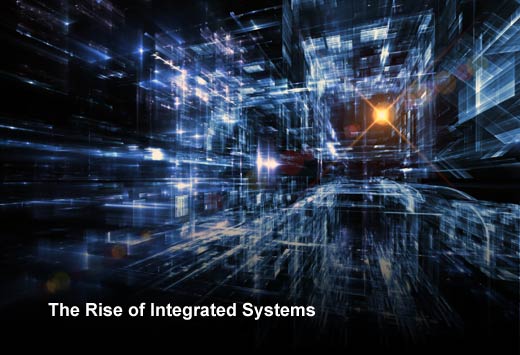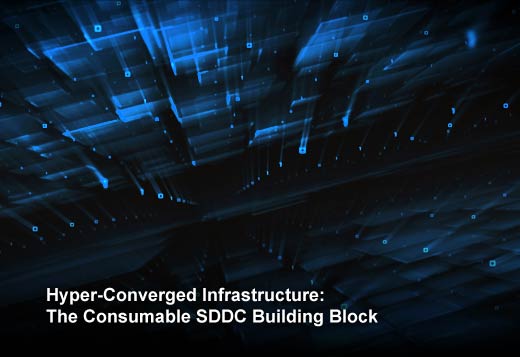In response to workers’ increasing demands for anytime, anywhere access to company data and applications, today’s CIOs and CTOs are turning to integrated IT infrastructure systems – converged and hyper-converged infrastructure solutions – to support a data center transition to cloud computing models built on the principles of the software-defined data center (SDDC).
SDDC architecture provides the needed flexibility, availability and security to stay ahead of workers’ expectations; ward off rogue incursions into shadow IT; and allow for easy, centralized management of all data center resources. Integrated systems support SDDC architecture with highly scalable, reliable and secure infrastructure solutions that can direct virtualized pools of compute, storage and networking resources wherever they are needed on demand.
In this slideshow, Skip Bacon, vice president, Products – Storage and Availability, VMware, and Bob Madaio, senior director, Infrastructure Platforms Marketing, Hitachi Data Systems, examine the advantages of integrated systems — including converged and hyper-converged infrastructure solutions — in delivering cloud agility, and explore the top use cases for integrated systems being adopted by enterprises today.
Integrated Infrastructure:Top Use Cases
Click through for more on the advantages of integrated systems in delivering cloud agility, as well as the top use cases for integrated systems being adopted by enterprises today, as identified by Skip Bacon, vice president, Products – Storage and Availability, VMware, and Bob Madaio, senior director, Product Marketing, Hitachi Data Systems.
The Problem
The IT community is facing significant disruption to their established service delivery methodologies as workers’ demand for immediate access to data and applications outstrips IT’s ability to deliver. Technology has moved beyond the legacy architecture companies have invested in over multiple budget cycles. This has led to worker frustration and the subsequent adoption of “shadow IT” practices as workarounds to now-balky protocols and unintended risks for the data center in the form of compromised security, capacity and scalability.
The Solution
Head to the cloud! Cloud computing environments based on the principles of the software-defined data center (SDDC), where compute, storage and networking resources are virtualized and bundled with robust management software, offer the needed agility to deliver applications and data on demand, in accordance with established security protocols, wherever workers are and on whatever devices they are using. Enterprises are flocking to cloud computing models: According to the RightScale 2016 State of the Cloud Report, 31 percent of enterprises are now running more than 1,000 virtual machines in a private cloud environment, up from 22 percent in 2015.
But what does this mean for your company’s legacy investments in traditional platforms?
Bimodal IT: Bridging Legacy and Cloud
For established companies reliant on traditional (non-virtualized) IT infrastructure platforms to deliver IT services, there is a path they can follow to tap into cloud agility without turning their backs on legacy investments. Technically, there are two paths, and they’re both part of the same conceptual approach: Bimodal IT. The research agency Gartner has identified Bimodal IT as “The practice of managing two separate, coherent modes of IT delivery, one focused on stability and the other on agility. Mode 1 is traditional and sequential, emphasizing safety and accuracy. Mode 2 is exploratory and nonlinear, emphasizing agility and speed.”
SDDC architecture supports a bimodal approach by centrally managing all environments – cloud and traditional – allowing for easy migration of workloads as business requirements dictate. But SDDC architecture is just half the story – to get the full benefit of cloud agility and traditional stability, you need a robust, secure, scalable infrastructure that can keep pace with your SDDC architecture workload for workload.
The Rise of Integrated Systems
Integrated systems, inclusive of converged and hyper-converged infrastructure, deliver out-of-the-box private cloud in a variety of form factors. Engineered and factory-assembled to support SDDC, integrated systems are widely seen as the ideal foundation for cloud environments and a bimodal approach. According to the research firm IDC, sales of integrated infrastructure grew 15.5 percent year over year during the second quarter of 2015 as enterprises continue to expand the range of workloads being deployed on these SDDC platforms.
Converged Infrastructure: Enterprise-Grade Data Center Solutions
For large enterprises seeking significant gains in operational efficiency while continuing to support applications running on legacy infrastructure, moving to an enterprise-grade converged infrastructure solution can greatly reduce OpEx over time by consolidating the overall IT infrastructure footprint, centralizing and automating infrastructure management, and offering the fastest path to a cloud-based IT-as-a-Service model. Converged infrastructure options can scale up the enterprise’s capacity to simultaneously accelerate application delivery and increase operational efficiency of the full range of Tier 1, Tier 2 and Tier 3 enterprise workloads, regardless of where they reside or how they are delivered within the bimodal model.
Hyper-Converged Infrastructure: The Consumable SDDC Building Block
At the other end of the integrated systems spectrum from the enterprise-grade converged infrastructure solution sits the hyper-converged infrastructure (HCI) appliance. HCI appliances provide low-threshold entry to cloud environments for enterprises not yet looking to make a wholesale transition to large-scale private cloud architecture. HCI features compute, networking and storage resources pooled in a software-centric design with a high degree of automation, running on commodity x86 hardware and packaged in a compact form factor. Each appliance has clearly defined capacity, so the IT organization can simply determine how much capacity the intended use cases require, buy as many appliances as are needed to achieve that capacity, and then stack these appliances together like building blocks in the data center.
Virtual Desktop Infrastructure
Integrated systems are ideal for supporting storage-intensive applications like virtual desktop infrastructure (VDI). In fact, while the variety of workloads being deployed on converged systems continues to expand, VDI remains the most common use case for HCI deployments. Because of the engineered and factory-integrated nature of key data center components, integrated systems can provide the consistent user experience with ultra-low latency which largely determines the success of a VDI deployment.
Agile Application Development
The development and operations (DevOps) dynamic is one that cries out for cloud agility. A DevOps initiative may start small, but workloads can grow explosively and require strong self-provisioning capability. Converged and hyper-converged infrastructure supported by strong management and orchestration software allows for easy creation, migration and elimination of workloads and their associated policies in a highly automated fashion, ideal for supporting the lightning-fast pivots that DevOps may frequently make. Linear scale-out agility that is the hallmark of SDDC on integrated systems allows for quick growth when needed, while avoiding the costly trap of overprovisioning for capacity that may never be needed.
Managing Geo-Distributed Infrastructure
For enterprises looking to support regional offices with a robust workforce but lacking a significant on-site IT presence, SDDC running on HCI appliances can provide the needed data center capacity and efficient remote support. Strong centralized management and orchestration capabilities enable lower OpEx by allowing IT organizations to consolidate their staffing resources, centralize oversight of multiple regional data centers, and reduce the level of on-site resources needed in each regional office as would be required to maintain legacy infrastructures.
Management and Orchestration
With SDDC architecture in place, your entire data center operations – including legacy infrastructure and cloud-based solutions – will benefit from powerful, single-point-of-management toolsets. Having visibility and control of the entire SDDC infrastructure means being able to automate and orchestrate the administration of task workflows required to support the complete IT environment.
Such end-to-end management tools reduce the complexity and maintenance challenges associated with the disjointed and inefficient coordination of underlying infrastructures. This efficiency saves both time and money, allowing the enterprise to focus its intellectual and financial resources on line-of-business objectives.
Conclusion
Emerging consensus reveals that the eventual future of IT services delivery will be not just cloud-based, but cloud-first. However, the Bimodal IT approach is more than a bridge; it is the relevant solution for the foreseeable future.
For the enterprise IT organization, the key lies in finding an IT infrastructure solutions provider that can service both tracks simultaneously with a suite of cloud-ready infrastructure solutions offering the right mix of simplicity, flexibility and scalability. This will ensure the ability to migrate workloads across a variety of infrastructure configurations via a single management and organization toolset.
SDDC on integrated systems will make your IT delivery more flexible, secure, scalable, seamless and efficient.














